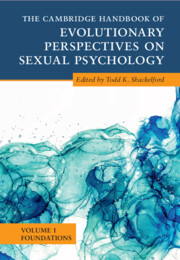Book contents
- The Cambridge Handbook of Evolutionary Perspectives on Sexual Psychology
- The Cambridge Handbook of Evolutionary Perspectives on Sexual Psychology
- Copyright page
- Contents
- Contributors
- Preface
- Part I Foundations of Evolution
- 1 Natural Selection
- 2 Sexual Selection
- 3 Inclusive Fitness Theory
- 4 Adaptive Problems in the Domain of Human Sexuality
- 5 Adaptations, By-products, and Spandrels
- 6 Evolved Psychological Mechanisms
- Part II Middle-Level Theories
- Index
- References
4 - Adaptive Problems in the Domain of Human Sexuality
from Part I - Foundations of Evolution
Published online by Cambridge University Press: 30 June 2022
- The Cambridge Handbook of Evolutionary Perspectives on Sexual Psychology
- The Cambridge Handbook of Evolutionary Perspectives on Sexual Psychology
- Copyright page
- Contents
- Contributors
- Preface
- Part I Foundations of Evolution
- 1 Natural Selection
- 2 Sexual Selection
- 3 Inclusive Fitness Theory
- 4 Adaptive Problems in the Domain of Human Sexuality
- 5 Adaptations, By-products, and Spandrels
- 6 Evolved Psychological Mechanisms
- Part II Middle-Level Theories
- Index
- References
Summary
In order to understand the domain of human sexuality, this chapter first explores the adaptive problems that shaped human sexual psychology. Adaptive problems are challenges or opportunities that had an impact upon the reproductive success of our ancestors. These problems gave rise to selection pressure for natural selection to create solutions in the form of physical and psychological adaptations. There are two broad classes of adaptive problem that humans can face: environmental forces and conspecifics. The chapter provides a brief survey of adaptive problems faced by humans throughout our evolutionary history and gives evidence for adaptations designed to solve these specific problems. We begin with adaptive problems dealing with the environmental forces of parasites, homozygosity, and pathogens. We then move to adaptive problems involving other people, specifically the problems of mate choice, commitment, and infidelity. We end the chapter with a brief discussion of past limitations and a call for evolutionarily inspired research into the full spectrum of human sexuality.
- Type
- Chapter
- Information
- Publisher: Cambridge University PressPrint publication year: 2022



